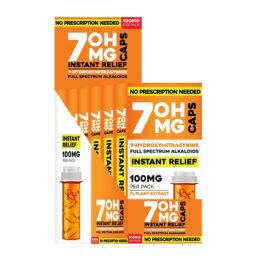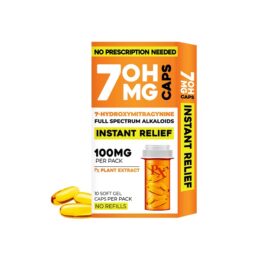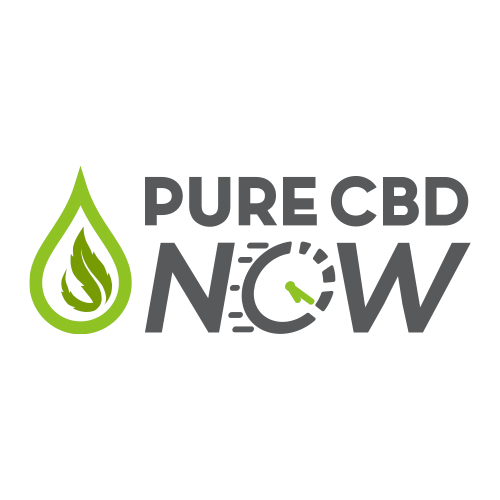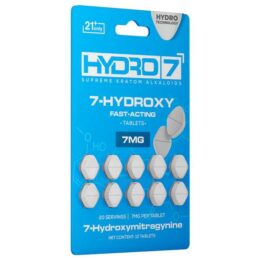Is Kratom A Psychedelic? Effects Explained
Discover amazing products designed just for you.
Featured Products

7-OHMG Softgel Caps 100mg Per Pack | 6-pack
Original price was: $299.00.$249.00Current price is: $249.00.
Add to cart
7-OHMG Softgel Caps | 100mg Per Pack
Original price was: $49.99.$39.99Current price is: $39.99.
Add to cartIs Kratom A Psychedelic? The Truth About Its Effects
Kratom is often misunderstood and sometimes classified with substances like psychedelics due to its powerful effects on the mind and body. However, kratom is not a psychedelic in the traditional sense, and its effects are quite different from those of substances like LSD, psilocybin, or DMT, which alter perception, cognition, and consciousness in profound ways. Here’s what sets kratom apart from psychedelics:
Primary Effects:
Kratom is a stimulant and opioid-like substance, depending on the dose. At lower doses, kratom may provide a burst of energy, increased focus, and enhanced sociability, similar to the effects of a stimulant. At higher doses, it acts more like an opioid, producing sedative effects, pain relief, and euphoria, which is why it’s often used for pain management or even as an aid in opioid withdrawal.
Psychedelic Characteristics:
Psychedelics typically cause altered sensory perceptions, such as hallucinations, distorted reality, and changes in thought patterns.1 Kratom doesn’t have these effects. Instead, its impact is more centered on the body, with a noticeable influence on mood, energy, and physical sensations like pain relief.
No Hallucinations:
Unlike classic psychedelics, kratom doesn’t cause visual or auditory hallucinations. While it may change how you feel or perceive emotions, it doesn’t lead to the altered states of reality that are characteristic of psychedelic substances.
How Kratom Works: Does It Affect The Brain Like Psychedelics?
Kratom and psychedelics, while both affecting the brain, operate in fundamentally different ways. Here’s a breakdown of their mechanisms:
Kratom’s Mechanism:
- Opioid Receptor Activation: Kratom’s primary action involves binding to opioid receptors in the brain.2 This interaction leads to pain relief, sedation, and a sense of relaxation, similar to the effects of opioid medications.2
- Other Receptor Interactions: Kratom also interacts with other brain receptors, including those regulating mood and energy levels. This explains its stimulant-like effects at lower doses.
Psychedelics’ Mechanism:
- Serotonin System Disruption: Psychedelics primarily target the serotonin system, specifically the 5-HT2A receptor.3 This disruption leads to profound alterations in perception, thought, and emotion, often resulting in visual and auditory hallucinations, synesthesia (mixing of senses), and ego dissolution.1
Kratom vs. Psychedelics: Key Differences You Need To Know
When exploring the world of natural remedies, it’s crucial to understand the distinctions between kratom and psychedelics. While both are derived from plants and have historical usage, the effects and classifications of these substances set them apart significantly.
Origin And Classification
Kratom, scientifically known as Mitragyna speciosa, is an evergreen tree native to Southeast Asia. It’s known for its stimulating and pain-relieving properties and is commonly used to alleviate chronic pain, anxiety, and opioid withdrawal symptoms.4 Kratom is not classified as a psychedelic; instead, it’s placed in a category of its own, primarily due to its unique active compounds: mitragynine and 7-hydroxymitragynine.
Psychedelics, on the other hand, include substances like LSD, psilocybin mushrooms, and DMT. These compounds are known for their profound changes in perception, mood, and cognitive processes. Psychedelics primarily interact with serotonin receptors in the brain, leading to experiences often described as hallucinations or altered states of consciousness.
Mechanism Of Action
Kratom acts principally on the opioid receptors in the brain, with its effects ranging from stimulation at lower doses to sedation and euphoria at higher doses. This spectrum of action is dependent on dosage and individual physiology. Kratom’s mechanism, therefore, aligns more closely with opioids than traditional psychedelics, which accounts for its unique classification.
Conversely, psychedelics affect serotonin pathways, particularly the 5-HT2A receptor, leading to their characteristic hallucinogenic effects. These substances often result in altered sensory perceptions, time distortion, and profound psychological experiences. The use of psychedelics is often explored for enhancing creativity, achieving spiritual experiences, or in some therapeutic contexts.
Purpose And Usage
The primary uses of kratom in modern settings are for pain management and mood enhancement. Many users turn to kratom as a natural alternative to pharmaceutical painkillers, benefiting from its ability to provide relief without the high-risk profiles associated with opioids.
Psychedelics, however, have a long associated history with cultural and spiritual practices aimed at exploring human consciousness. In recent years, research into their potential therapeutic benefits for mental health conditions5 has garnered significant attention, although their legal status remains complex in many regions.
Does Kratom Cause Hallucinations? What Science Says
To answer the question of whether kratom causes hallucinations, based on current scientific understanding, the short answer is: generally, no. Hallucinations are not a typical or expected effect of kratom use. Here’s a breakdown of what science says:
- Kratom’s Mechanism Of Action: Kratom’s primary effects stem from its interaction with opioid receptors in the brain. While it also interacts with other receptor systems, its main action is not on the serotonin system in the same way that classic psychedelic drugs do. Psychedelics, which do cause hallucinations, primarily work by affecting the serotonin system, specifically the 5-HT2A receptor.
- Lack of Serotonergic Activity: Kratom does not significantly stimulate the 5-HT2A receptor, the key target for hallucinogenic drugs. This is the primary reason why kratom does not typically produce hallucinations.
- Reported Effects: The most commonly reported effects of kratom include pain relief, mood elevation, increased energy (at lower doses), sedation (at higher doses), and relaxation.6 Hallucinations are not among these typical effects.
- Rare Occurrences And Contributing Factors: While true hallucinations are rare with kratom, some users have reported mild visual or auditory distortions, particularly at very high doses.7 However, these are not the same as the vivid and complex hallucinations associated with psychedelics. In these rare cases, other factors might be at play, such as the following:
Extremely high doses of kratom might lead to unusual sensory experiences, but these are more likely distortions or enhancements of existing perceptions rather than true hallucinations.
Combining kratom with other drugs, especially other psychoactive substances, can increase the risk of unpredictable and potentially hallucinogenic effects. This is extremely dangerous and strongly discouraged. If hallucinations do occur, it’s more likely due to the interaction of substances, not kratom alone.
Everyone reacts differently to substances. Some individuals might be more susceptible to unusual perceptual changes with kratom, even at moderate doses. However, this is not the norm.
If the kratom product is impure or contaminated with other substances, it could potentially lead to unexpected and potentially hallucinogenic effects. This emphasizes the importance of sourcing kratom from reputable vendors who conduct third-party testing.
The Effects Of Kratom At Different Doses: Stimulant Or Sedative?
It exhibits stimulant-like or sedative properties at different intake levels, making it a unique botanical subject of considerable interest.
Low Dose Effects: Stimulant
When taken in smaller amounts, typically 1 to 5 grams, kratom acts predominantly as a stimulant. Users often report increased alertness, enhanced energy levels, and a higher capacity for concentration. This is because, at lower doses, kratom’s interaction with the body’s adrenergic system closely mimics that of common stimulants. These effects can be particularly appealing for those seeking a natural alternative to enhance productivity.
Moderate To High Dose Effects: Sedative
Conversely, at higher doses — usually between 5 and 15 grams — kratom tends to produce sedative effects. In this range, the alkaloids in kratom, such as mitragynine and 7-hydroxymitragynine, bind more extensively to opioid receptors in the brain. This interaction can lead to feelings of relaxation, pain relief, and sometimes euphoria. While these effects might be sought for unwinding or managing discomfort, they highlight the importance of mindful dosage to suit desired outcomes.
Balancing Dosage For Desired Results
Understanding the dichotomy in kratom’s effects emphasizes the significance of careful dosage tailoring to match individual needs and expectations. As with any wellness product, responsible use is imperative to maximize benefits while minimizing potential drawbacks. Always consider consulting with a knowledgeable professional when making choices about kratom use, and remember that effects can vary based on individual physiology and other factors.
Is Kratom Safe? Potential Risks, Side Effects, And Dependence
Kratom has become increasingly popular as a natural remedy for pain management, mood enhancement, and energy boosts. Yet, as with any supplement that affects the brain and body, it’s essential to understand the potential risks and side effects associated with its use.
Potential Risks And Side Effects
Kratom can produce a variety of effects depending on the dosage and individual differences. While many users seek kratom for its potential to enhance mood or alleviate discomfort, it’s essential to consider possible side effects. Common side effects include nausea, dry mouth, constipation, and dizziness.
Risk Of Dependence
Another critical consideration is the potential for dependence. Regular use of kratom can lead to tolerance, where users experience diminished effects and may feel compelled to increase their dosage. This cycle could result in dependence, characterized by withdrawal symptoms such as irritability, mood swings, and cravings upon cessation. Users must be mindful of their consumption patterns and consult healthcare professionals if necessary.
Read Also:
- Is Kratom Safe? Benefits And Risks Explained
- How Does Kratom Work? Effects And Mechanism
- Kratom Side Effects: Risks And What To Expect
Sources:
- National Institute on Drug Abuse. (2023, April). Psychedelic and Dissociative Drugs. National Institute on Drug Abuse. https://nida.nih.gov/research-topics/psychedelic-dissociative-drugs
- Annuar, Ummi Kalthum Azlan, Mediani, A., Tong, X., Han, R., Ebtesam Al-Olayan, Syarul Nataqain Baharum, Hamidun Bunawan, Murni Nazira Sarian, Hamizah Shahirah Hamezah, & Ibrahim Jantan. (2024). An insight review on the neuropharmacological effects, mechanisms of action, pharmacokinetics and toxicity of mitragynine. Biomedicine & Pharmacotherapy, 171, 116134–116134. https://doi.org/10.1016/j.biopha.2024.116134
- López-Giménez, J. F., & González-Maeso, J. (2018). Hallucinogens and Serotonin 5-HT2A Receptor-Mediated Signaling Pathways. Current Topics in Behavioral Neurosciences, 36, 45–73. https://doi.org/10.1007/7854_2017_478
- Prevete, E., Hupli, A., Marrinan, S., Singh, D., Udine, B. D., Bersani, G., Kuypers, K. P. C., Ramaekers, J. G., & Corazza, O. (2021). Exploring the use of Kratom (Mitragyna speciosa) via the YouTube data tool: A novel netnographic analysis. Emerging Trends in Drugs, Addictions, and Health, 1, 100007. https://doi.org/10.1016/j.etdah.2021.100007
- Barber, G. S., & Aaronson, S. T. (2022). The Emerging Field of Psychedelic Psychotherapy. Current Psychiatry Reports, 24(10). https://doi.org/10.1007/s11920-022-01363-y
- Cutlip, H. A., Bushman, E., Thottumari, L., Raja Mogallapu, & Ang-Rabanes, M. (2021). A Case Report of Kratom-Induced Psychosis. https://doi.org/10.7759/cureus.16073
Frequently Asked Questions About Is Kratom A Psychedelic?
Is kratom legal?
The legality of kratom varies significantly across countries and even within regions in the United States. Some places have fully legalized its use, while others have imposed restrictions or outright bans. It’s crucial to check the specific laws related to kratom in your locality before purchasing or using it.
What are the active compounds in kratom?
Kratom leaves contain several active compounds, the most notable being mitragynine and 7-hydroxymitragynine. These alkaloids interact with the brain’s opioid receptors, potentially resulting in effects ranging from stimulation to sedation, depending on the dosage.
How do you use kratom responsibly?
Responsible use of kratom involves understanding and adhering to recommended dosages, being aware of possible side effects, and using it in moderation. It’s advisable to consult with a healthcare professional, especially if you’re considering using kratom for medical purposes or are currently taking other medications.
Can kratom help with opioid withdrawal?
Some individuals have used kratom to help manage symptoms of opioid withdrawal,4 as its compounds can interact with the same brain receptors opioids target. However, scientific research on this use is limited, and kratom itself can be habit-forming, so it’s essential to approach this potential use with caution and under professional guidance.
How long do kratom’s effects last?
The duration of kratom’s effects typically ranges from 2 to 6 hours, depending on the dose, the form of kratom consumed, and individual metabolic factors. Lower doses often produce more stimulating effects, while higher doses are associated with sedatives.
What are the different forms of kratom available?
Kratom is available in several forms, including powder, capsules, extracts, and teas. Each form may offer different benefits depending on personal preference and the desired effect. Choosing a form that aligns with your wellness goals and usage preferences is important.








